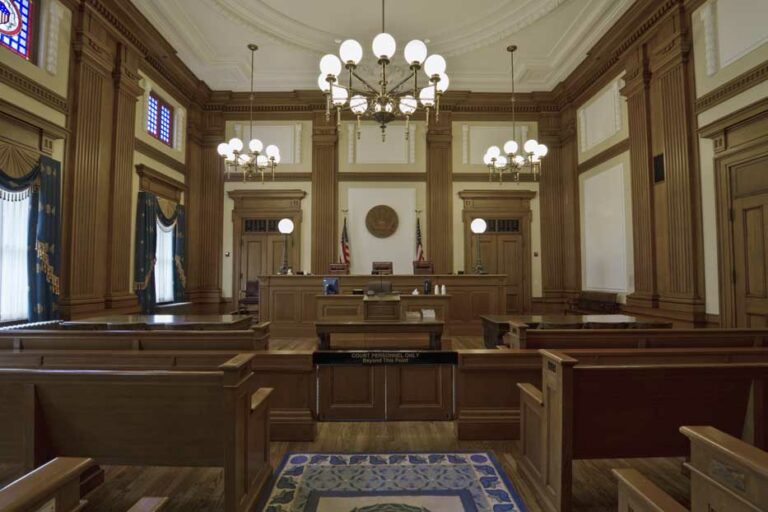Business Hours
Monday - Friday
8 AM - 5 PM
Weekend
Closed
Business Hours
M -F
8 AM - 5 PM
Weekend
Closed
After a person is arrested by law enforcement for a felony offense in Pima County (and most misdemeanors outside of city limits), they will be processed, or “booked,” into the Pima County jail for fingerprinting and an assessment of their medical and mental health needs. Release decisions are made within 24 hours; until such a decision, the detained person remains in a holding cell and may be transferred to a single- or two-person cell later if they are not released.
The person in custody is brought before a judge within 24 hours of their arrest and advised of the initial charges alleged by law enforcement. At this time, a judge will set a date for the next court proceeding and determine – after listening to arguments from both the prosecutor and defense attorney – the release conditions that the person arrested must meet, including if a bond must be paid. The Court receives information about the person’s background and risk factors (determined by Pretrial Services) to decide whether pretrial detention is necessary. Victim and community safety is the most important factor. If held in custody, the person is still presumed innocent at this phase but will be held in custody only until they face a trial or plea.

A prosecutor reviews the evidence submitted by law enforcement to determine if it is sufficient to file formal criminal charges against the person who was arrested. If the evidence is not sufficient, the person arrested will be released. If the evidence is sufficient for formal charges, the prosecutor must present the evidence either to a Grand Jury or to a judge at a Preliminary Hearing within 10-20 days.
For a case to go forward, a hearing before a Grand Jury (which is closed) or before a judge must happen in order to determine if “probable cause” exists. (To learn more about probable cause, click here.) The finding of probable cause is a check on the power of the government to prosecute its citizens. If the Grand Jury or a judge cannot determine that probable cause exists in the case brought forth, the person charged will be released.
At the Arraignment, the person charged is advised of their rights, and a plea of "guilty" or "not guilty" is entered on their behalf. From this point forward, the person charged is typically referred to as “the defendant” by the Court and prosecutors.
Discovery is the process of both the prosecutor (representing the State) and the defense attorney (which may be a public defender or private attorney representing the person who was charged) building their case and submitting any evidence to the Court that they may have acquired. The State must disclose all evidence to the defense attorney to ensure they are able to effectively represent their client. Pretrial motions are tools used by each party to set boundaries for the trial. Determinations on what sort of evidence can be used and what legal arguments will be allowed are discussed at this point. After this stage, the case will either go to trial or a "non-trial disposition" in the form of a "plea agreement" or "dismissal.”

Some trials may be relatively quick (1-2 days), while others may last for weeks at a time. Some trials require a jury to decide on guilt, and others may be decided by a judge. Trials involve several phases, including Jury Selection; Opening Statements; Prosecutor's Case in Chief, which involves the presentation of evidence and witness testimony; Defense Case (optional); Prosecutor's Rebuttal to the Defense (optional); Closing Arguments; Jury Instructions; Jury Deliberations; and, finally, the Verdict. Depending on the verdict, the Defense may file any number of motions, most notably for a new trial.
The convicted person faces either incarceration or probation. Sentencing ranges, according to State laws, are determined by class, nature, and/or severity of the offense(s). (You can view Arizona’s Criminal Code Sentencing Provisions by clicking here.) At a Sentencing Hearing, the prosecutor and defense attorney will have an opportunity to convince a judge to sentence the convicted person to what they believe is appropriate. Often, the victims in a case will want to speak to the Court about how they were impacted by the convicted person’s actions. And finally, before the judge hands down their sentence, the convicted person may also take the opportunity to accept responsibility for any harm they committed and express remorse for their actions.
If the convicted person is sentenced to incarceration, they may be transferred from the custody of the County Jail to the Arizona Department of Corrections, Rehabilitation and Re-entry (ADCRR). Upon transfer, the convicted person will be processed by ADCRR (which may take a couple of days or multiple weeks) before being transported to any of ADCRR’s 17 state prison complexes/units. (You can view a map by clicking here.)
Every convicted person has the right to an appeal. If a convicted person or their defense attorney believes that the treatment they received was unjust, unfair, or unconstitutional at any point during the felony legal process, they may file an Appeal with the Court – specifically, Arizona’s Court of Appeals – which may grant a new trial. If the convicted person did not go to trial and either pled guilty directly to the Court or signed a plea agreement, the defense may file for what is called “post-conviction relief,” or Rule 33 of Arizona’s Rules of Criminal Procedure. The Judge who heard their case would decide if an error was made that requires action.
After a person is arrested by law enforcement for a felony offense in Pima County (and most misdemeanors outside of city limits), they will be processed, or “booked,” into the Pima County jail for fingerprinting and an assessment of their medical and mental health needs. Release decisions are made within 24 hours; until such a decision, the detained person remains in a holding cell and may be transferred to a single- or two-person cell later if they are not released.
The person in custody is brought before a judge within 24 hours of their arrest and advised of the initial charges alleged by law enforcement. At this time, a judge will set a date for the next court proceeding and determine – after listening to arguments from both the prosecutor and defense attorney – the release conditions that the person arrested must meet, including if a bond must be paid. The Court receives information about the person’s background and risk factors (determined by Pretrial Services) to decide whether pretrial detention is necessary. Victim and community safety is the most important factor. If held in custody, the person is still presumed innocent at this phase but will be held in custody only until they face a trial or plea.

A prosecutor reviews the evidence submitted by law enforcement to determine if it is sufficient to file formal criminal charges against the person who was arrested. If the evidence is not sufficient, the person arrested will be released. If the evidence is sufficient for formal charges, the prosecutor must present the evidence either to a Grand Jury or to a judge at a Preliminary Hearing within 10-20 days.
At the Arraignment, the person charged is advised of their rights, and a plea of "guilty" or "not guilty" is entered on their behalf. From this point forward, the person charged is typically referred to as “the defendant” by the Court and prosecutors.
For a case to go forward, a hearing before a Grand Jury (which is closed) or before a judge must happen in order to determine if “probable cause” exists. (To learn more about probable cause, click here.) The finding of probable cause is a check on the power of the government to prosecute its citizens. If the Grand Jury or a judge cannot determine that probable cause exists in the case brought forth, the person charged will be released.
Discovery is the process of both the prosecutor (representing the State) and the defense attorney (which may be a public defender or private attorney representing the person who was charged) building their case and submitting any evidence to the Court that they may have acquired. The State must disclose all evidence to the defense attorney to ensure they are able to effectively represent their client. Pretrial motions are tools used by each party to set boundaries for the trial. Determinations on what sort of evidence can be used and what legal arguments will be allowed are discussed at this point. After this stage, the case will either go to trial or a "non-trial disposition" in the form of a "plea agreement" or "dismissal.”

Some trials may be relatively quick (1-2 days), while others may last for weeks at a time. Some trials require a jury to decide on guilt, and others may be decided by a judge. Trials involve several phases, including Jury Selection; Opening Statements; Prosecutor's Case in Chief, which involves the presentation of evidence and witness testimony; Defense Case (optional); Prosecutor's Rebuttal to the Defense (optional); Closing Arguments; Jury Instructions; Jury Deliberations; and, finally, the Verdict. Depending on the verdict, the Defense may file any number of motions, most notably for a new trial.
If the convicted person is sentenced to incarceration, they may be transferred from the custody of the County Jail to the Arizona Department of Corrections, Rehabilitation and Re-entry (ADCRR). Upon transfer, the convicted person will be processed by ADCRR (which may take a couple of days or multiple weeks) before being transported to any of ADCRR’s 17 state prison complexes/units. (You can view a map by clicking here.)
The convicted person faces either incarceration or probation. Sentencing ranges, according to State laws, are determined by class, nature, and/or severity of the offense(s). (You can view Arizona’s Criminal Code Sentencing Provisions by clicking here.) At a Sentencing Hearing, the prosecutor and defense attorney will have an opportunity to convince a judge to sentence the convicted person to what they believe is appropriate. Often, the victims in a case will want to speak to the Court about how they were impacted by the convicted person’s actions. And finally, before the judge hands down their sentence, the convicted person may also take the opportunity to accept responsibility for any harm they committed and express remorse for their actions.
Every convicted person has the right to an appeal. If a convicted person or their defense attorney believes that the treatment they received was unjust, unfair, or unconstitutional at any point during the felony legal process, they may file an Appeal with the Court – specifically, Arizona’s Court of Appeals – which may grant a new trial. If the convicted person did not go to trial and either pled guilty directly to the Court or signed a plea agreement, the defense may file for what is called “post-conviction relief,” or Rule 33 of Arizona’s Rules of Criminal Procedure. The Judge who heard their case would decide if an error was made that requires action.